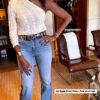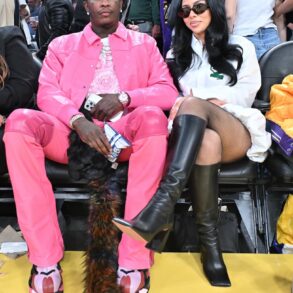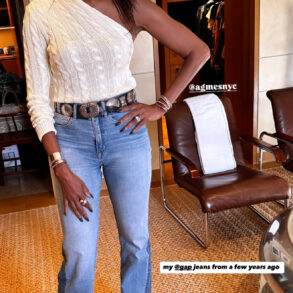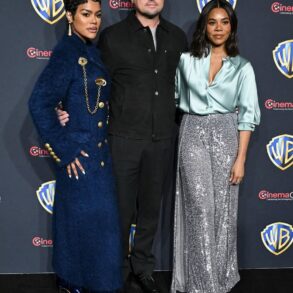Twenty-two stories above the palm-tree-studded court of the Brookfield Place mall in Battery Park City, the creative director of J. Crew men’s wear, Brendon Babenzien, was dressed for work on a sunny October morning in a chambray shirt and jeans, topped by a Shetland wool cardigan.
Bedecked with rows of pastel pink roses, blue daisies and purple irises, this tea cozy of a garment would have looked at home on Mrs. Doubtfire. On a founding father of fashion’s streetwear era — who, it’s worth noting, designed the sweater not for his day job at J. Crew, but rather for his own label, Noah — it read as intended: ironic, a little subversive. Very secure in its coolness.
This was a garment that, in many ways, the retailer Arthur Cinader could never have prognosticated back in 1983 when he founded J. Crew. At the dawn of the preppy era, Mr. Cinader named his mail order business after an Ivy League sport and slapped the initial “J” in front to conjure the illusion of provenance.
In the 40 years since, the preppy aesthetic Mr. Cinader wanted to mass-market has been rejected and embraced, defined and redefined so many times that today, a Nirvana T-shirt has apparently entered the Gen Z notion of “how preppies dress.” Along with it, whatever constitutes “American style,” and the whims of the American consumer have zigged and zagged, and the company Mr. Cinader started has striven — sometimes with great success — to keep up.
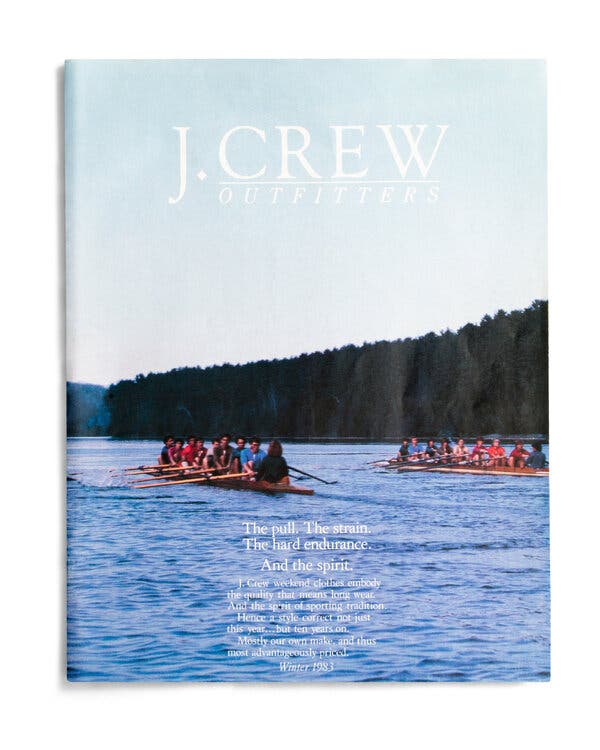
Along the way, J. Crew matured into what it started out pretending to be: an American brand with real history. Er, heritage. Parts of that history, the brand would prefer to forget: the long creative malaise of the later 2010s, when its quality slid and its debt mounted; the departure, in 2017, of the creative director and president Jenna Lyons, whom most consumers thought of as the brand’s human embodiment, and the ensuing identity crisis; the brush with death when J. Crew became the first major American retailer to file for Covid-era bankruptcy.
Many assumed that the bankruptcy filing, in 2020, would spell the end of J. Crew. It turned out to be a Hail Mary. The company gave control to its creditors, led by the investment firm Anchorage Capital; that firm and other investors helped the company deal with a crippling $1.6 billion debt and supplied a $400 million line of credit to fund a restoration effort. Six months after filing for bankruptcy, its revolving-door chief executive slot was filled by Libby Wadle, a longtime J. Crew and Madewell veteran.
Almost three years to the date after her appointment, Ms. Wadle, 50, sat on a couch in her corner office, recalling “the most uncertain and tumultuous” retail period she had ever witnessed. Since the start of the pandemic, “no one year has behaved the same way for a retailer. No quarter has been the same way,” she said.
Yet with the help of a pair of shiny recruits — the designer Olympia Gayot, who worked at J. Crew from 2010 to 2017, and is now back to lead women’s and children’s design; and Mr. Babenzien, who led Supreme, the skate shop turned fashion force — Ms. Wadle has stanched any obvious bleeding.
It’s tough to gauge her recovery efforts, given that J. Crew is privately held and does not disclose much financial data. (“I love being private!” Ms. Wadle said at one point during our interview.)
But there are promising signs. The company said that A.O.V., or average order value — the amount shoppers spend in a single transaction — is back up. Yes, there is still a steady stream of markdowns and discounts, particularly online, but “we don’t lead with promotions anymore,” Ms. Wadle said.
Many customers, Ms. Wadle said, are paying full price again, and buying complete outfits as opposed to single pieces. A shiny new women’s boutique bearing Ms. Gayot’s imprint is set to open in the spring, on Spring Street in SoHo — bringing J. Crew back to the neighborhood for the first time since 2018.
During New York Fashion week in September, the company hosted a 40th birthday party on the capacious rooftop of Pier 17 (the brand opened its first store there in 1989) featuring a big-ticket headliner. It was hard to see the connective tissue between that act, the Strokes, and their host — a cognitive dissonance that the frontman Julian Casablancas seemed to nod to when, near the end of a convincingly sweaty set, he told the crowd, “It’s been real. It’s also been a little fake.” Pause. “I’m kidding.”
The odd moment of snark aside, the mood at HQ is pretty perky. Still, nobody’s quite using the word “comeback.” Ms. Wadle said that in its glory days, J. Crew “owned” up to 90 percent of its core customer’s wardrobe. At its height, in 2015, J. Crew operated 285 stores; today there are 119. Ms. Wadle, understandably, would like to move the goal posts. “I’m not trying to do much that goes back to what we once were,” she said.
Asking any establishment retailer to put the genie back in the bottle in an era in which the mall brand itself is kind of a heritage concept seems like wishful thinking. Abercrombie & Fitch, Ann Taylor and Victoria’s Secret are all scrambling through various stages of crisis and turnaround efforts.
On top of this, J. Crew once had a hold on American style that far exceeded both its footprint and bottom line. Back when its Michelle Obama-era spiffed-up sparkle and skinny Ludlow suits were seemingly inescapable, J. Crew became part of the broader conversation of style and culture in a way that, say, Club Monaco or Banana Republic have never been.
Ms. Wadle acknowledges that the days when consumers wore a single brand head to toe are done. “That’s not how we shop anymore,” she said.
How we shop, or get inspired to shop, these days is largely through our phones. Here is where Ms. Gayot, 42, has the touch. While Mr. Babenzien, 51, had the GQ–reading men’s wear enthusiast at hello, Ms. Gayot was a relative unknown when she took her post.
Since 2021, when her bosses asked her to make her Instagram account public, her following has gone from under 1,000 to 148,000. She’s not on TikTok, yet a search of her name there pulls up 2.2 million views. The selfies Ms. Gayot casually shoots in the full-length mirror of her office of herself wearing J. Crew with enviable ease — topped by her trademark mane of Botticelli curls — are starting to fill that Jenna Lyons cult-of-personality void without getting exactly personal, as Ms. Lyons is wont to do. They also cannily supply a steady feed of fresh looks and styling ideas.
For a brand that is not fast fashion, which plans its collections nine months to a year out, and metes out new goods in photo shoots released online every two weeks or so, Ms. Gayot’s feed is a gold mine.
Ms. Gayot started her new job in the very early days of the pandemic, pregnant with her second child and coming into the office daily, long before a vaccine was on the horizon.
She began designing by going through her own wardrobe. “I pulled out all of my favorite things, things I’ve worn forever, because that’s how I get dressed: in old photos, I’m wearing the same thing for years, just styled in different ways,” she said. Those standbys included trench coats, loafers and cashmere sweaters. She set about reinventing their proportions for the 2020s, “how low is the skirt sitting? How shrunken is the sweater?”
How boxy is the pinstripe suit? The first one Ms. Gayot designed, soon after she started her new job, was not dissimilar to the men’s-wear-inspired model she was wearing in her office the day we spoke. In J. Crew parlance, it was a look “borrowed from the boys,” that she’d styled with a fashion insider’s flair: pushed up sleeves, gold jewelry, tall patent-leather boots. Her first attempt at pinstripes, “we couldn’t sell,” she said with a laugh. “But this one sold out in, like, three days. The whole suit and the vest.” Ditto an Oxford-style loafer. Her first attempt was dead in the water. “Now — gone.”
Rest easy, mainstream American male: You will not see flower-dotted granny cardigans in J. Crew men’s stores. Not anytime soon, at least. Ms. Wadle said that for all his cool-kid cred, Mr. Babenzien is well attuned to his new customer’s comfort zone. “Brendon will always say, if he’s wearing something now, maybe regular guys will be wearing it a year or two from now,” Ms. Wadle said. The internet went wild early in Mr. Babenzien’s tenure when he introduced an improbably wide-legged giant-fit chino. But since then his clothes have felt surprisingly safe.
The fashion-forward imagery the company releases to more insider-y press outlets conveys a completely different mood from the way the clothes appear in stores. There, the looks mostly hew to an aesthetic Mr. Babenzien describes as “pre-prep” — inspired by a simple, functional mode of American dress from a time before the word “preppy” got loaded down with aspirations of wealth and class.
But after a decade of loud, streetwear- and sneaker-culture-driven men’s fashion, Mr. Babenzien said the winds of cool are turning in J. Crew’s direction. Classic, clean-cut clothes — “the fundamentals,” Mr. Babenzien likes to call them — look hip again. “I’ve seen it happen three times in my career,” he said. “It’s a pendulum, and it swings back and forth forever.”
What Ms. Wadle, Ms .Gayot and Mr. Babenzian share is a deep faith in the source material, a belief in J. Crew as a significant, multigenerational force in American style that has earned its Breton stripes and deserves a place in the same conversation as Ralph Lauren. Mr. Babenzien noted that in terms of design, the seemingly downtrodden J. Crew he arrived at in 2021 was not nearly as broken as headlines suggested. And at the J. Crew men’s and women’s stores located an elevator ride down from their offices, this belief — that J. Crew needed a restoration, not a revolution — played out in physical expression.
In the women’s store, the silhouettes were in step with 2023: the jackets boxy; a few tops judiciously cropped; waistbands high; loafers chunky. Still, here was the full Crayola box of cashmere, 12 hues in all. The jean jacket tossed over a striped sweater (were those clear sequins on the sweater? They were.) The micropleated skirt as shiny as Charlie Bucket’s golden ticket. Even the statement necklace was present and accounted for — not the bubble necklace of yore, but a circlet of Gobstopper-size faux pearls tied with velvet.
In person, removed from the cool-looking and diverse models who now populate J. Crew imagery, the mix was akin to how Ms. Wadle had described it upstairs: celebratory and cozy, nostalgic yet current — without being too “forward,” a mistake that burned J. Crew in the past. It also felt exceedingly … familiar.
The firepower J. Crew had in the late aughts was ignited by a look that was novel. Ms. Lyons, working with the stylist Gayle Spannaus, and given the green light by Mickey Drexler — then the chief executive — took the building blocks (denim, chinos, prep, cashmere, men’s wear, simplicity), sprinkled in surprise ingredients (sparkle, sequins, neon, camo, even the odd tuft of feathers), and threw the whole lot in a blender.
The new crew seems to want to pull off a similar feat, not by breaking the mold but by reining in past excesses and giving the existing codes a loving tweak. Of course even Ms. Lyons’s look, which in hindsight appeared to be an overnight sensation, took trial and error and time to really nail. Now, J. Crew has survived its big fall. But will it be “back”?
Ms. Lyons herself seemed to acknowledge this question, however unintentionally, in an Instagram post on the day after the brand’s 40th anniversary party this past September: “I’m rooting for you J. Crew.”
This post was originally published on this site be sure to check out more of their content.


